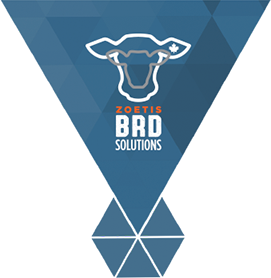BRD management: What works Doc?
December 31, 2018
Learn the answer to one of the most frequently asked questions: “What works best for treating bovine respiratory disease (BRD)?”
One of the questions that I hear most frequently is: “What works best for BRD, Doctor?” And while there have been many changes in the industry over my 30-year career, my response to this question remains the same: “What works best today is what has always worked.”
To help improve BRD treatment success, I recommend three important tips – maximize animal husbandry, minimize stress and use the best available products.
- Maximize animal husbandry
- Provide the best possible care and housing. When working with producers, my first focus is not to change their product. I first concentrate on helping them identify things that could be contributing to BRD challenges and/or treatment failure. This means ensuring cattle receive excellent nutrition to complement a successful immune system and decreasing disease challenge by minimizing effects of the environment and management. During the cold winter months, shelter cattle from the elements and provide a dry place to bed. During the summer, keep them cool with ample shade.
- Offer clean, fresh water. Sometimes we get caught up in the day-to-day, and we don't think about water troughs. Are they filled with a murky sludge, or is the water fresh and clean to encourage adequate intake? Keep in mind that dehydration can compromise the immune system, allowing harmful BRD pathogens to enter the lungs. For perspective, if you were thirsty, would you take a sip from your herd's water trough?
- Minimize stress
- Shorten transportation time. Consider the stress of hauling cattle to and from different segments of our industry. You know how stressful it can be just loading and hauling cattle down the road while in the driver's seat of your pickup. Now, imagine the stress of a 12- to 15-hour ride, shoulder to shoulder, in a dark, wet cattle truck with up to 100 calves. Here are a few considerations to help minimize the impact of stress on your cattle: Is it an option to shorten the transportation time? Can you improve the cleanliness and comfort in the trailer and make sure the diesel exhausts are above the trailer? Some people use bedding in cattle liners, maybe more of us should?
- Minimize commingling. Remember that cattle are very social because of their herd behaviour, and when we change the makeup of the herd, it can increase stress and lead to increased risk of disease.
- Use low stress handling. By lessening the stress of handling cattle and minimizing stress from introducing cattle to new environments, we can further decrease the risk of BRD.
- Use the best available products
- Consider the whole picture. If you're doing a good job minimizing stress and increasing the well-being of your cattle, using the best available products will prove even more effective for your cattle. Their immune systems will be stronger, and their risk of disease will decrease. When choosing a product, it is more important to evaluate efficacy than just compare costs. Often, more expensive products bring savings above the initial cost in areas not being measured. For example, a more effective antibiotic can reduce the time spent re-treating cattle, thus reducing your labour and medicine costs. Treating cattle costs money but also takes time — and finding more time in a day is not easy. Better treatment response also leads to fewer costly chronic or dead cattle.
- Measure the value. You can't manage what you don't measure, so keeping records is critical to your success. However, data is valuable only if you are analyzing and making decisions from it. Information can be even more useful when used with professional help, whether this is a nutritionist, local veterinarian consultant or company technical services representative. For instance, a feedlot manager I was working with thought the antibiotic he was using was not working as well because he was treating more cattle every day. By evaluating records, I pointed out that the efficacy of the product wasn't the problem. In fact, the treatment response rate had not changed. What had changed was the number of new cattle they were receiving, which is why they were treating more cattle every day. Through better identification of the problem, you can find a better solution. The question of “What's working for BRD, Doc?” is a great question. But the answer will never be as simple as “use this or that product”. Better BRD management and treatment outcomes can always be achieved when you do three things well – maximize animal husbandry, minimize stress and use the most effective products available.
About the author: Dr. Jeff Sarchet has been with Zoetis since 2013 and is part of an experienced Zoetis Technical Services team helping cattle producers and veterinarians across the country achieve their business goals. Like all members of the team, he brings years of practicing veterinary experience, specifically more than 25 years of cow/calf, stocker and feedlot consulting experience.



